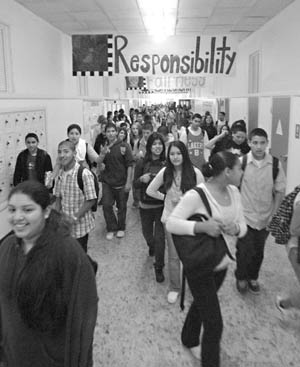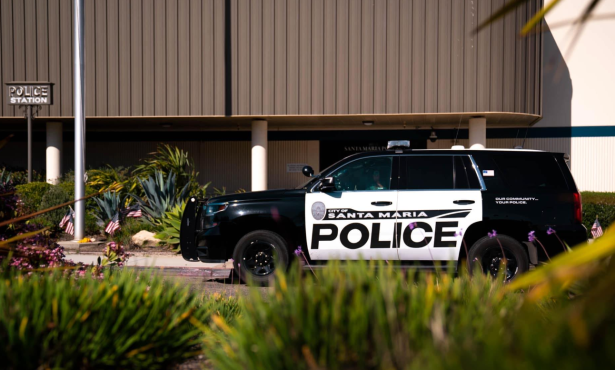Collision Course
School Board Considers Merging La Cumbre and Community Academy Campuses

Times are tough in the Santa Barbara School District. With declining enrollment having progressed from a troubling trend to a harsh reality, the task of balancing budgets in both the elementary and high school districts has grown exponentially more difficult. During these financially trying times, progress on long-desired facility improvements has slowed to a snail’s pace, while the notion of school closure, once an ignored elephant in the room, has become an agenda item demanding ongoing discussions and research. Even the district’s victories seem tainted of late-for instance, seven months of strenuous negotiations between the district and its teachers finally ended in a new contract last week, but only after class sizes were increased for grades 4 through 12, which will most likely result in fewer teacher positions next year.
But perhaps the greatest indicator of this disconcerting state of affairs is the board’s deliberations on the fate of the ¼ber-successful Santa Barbara Community Academy elementary school and the long-embattled but recovering La Cumbre Junior High. Under a flag of economic prudence, the board is seriously considering moving the academy to the underutilized La Cumbre site, essentially pitting two of the district’s success stories against each other. To school boardmember and academy cofounder Bob No»l, the very idea is “just plain tragic. The whole thing is a complete mess and it just breaks my heart.”
The trouble began during a whirlwind Facilities Master Plan update hearing last August, when the board surprisingly approved conceptual plans to site the entire academy on the La Cumbre campus. (Grades 4-6 of the academy were moved to La Cumbre in 2005.) Though the decision was tentative, pending review by land-use consultants Pat Saley and Associates, it immediately sent shock waves through the La Cumbre community. As academy parents and staff celebrated the prospect of a unified, permanent, and more spacious home, a resistance was forming at La Cumbre’s upper Westside campus, where district-mandated changes have, for better and worse, been a disruptive reality for many years.
La Cumbre has suffered from declining enrollments; on-again, off-again status for the 6th grade (currently off); contentious principal changes; and failed attempts to relocate both Open Alternative School and Santa Barbara Charter School to the campus. But district officials, parents, and teachers all agree the Lancers are experiencing a revival, evidenced by increasing enrollment and improving test scores, due in no small part to Principal Jo Ann Caines’s leadership. At a board hearing last month, No»l commented on these changes: “Something very special is happening at La Cumbre and whatever works out [with the merger], we must not stop that momentum.”
But that is precisely what the La Cumbre community fears will happen in the case of a campus merger. For 12 weeks straight, La Cumbre teachers and parents have voiced this concern to the board-whether or not the matter was on the agenda-by attending public comment periods and inviting school boardmembers out for site visits and PTA sit-downs. Those opposed to the separate but equal coexistence of elementary and junior high students on the same campus have pointed to myriad ways the merger could stifle the junior high’s current progress, including increased noise from hundreds of additional students in the hallways, social misgivings about 5-year-olds sharing bathrooms with 13-year-olds, and the logistical nightmare of putting more cars in the already traffic-challenged parking lot and surrounding neighborhood streets. As La Cumbre teacher Laura Baker explained, “We have nothing against the academy : . We are simply against a move of elementary students onto our site-especially now.”
With La Cumbre’s enrollment finally bucking district trends and increasing, there is also concern that such a change to the school’s landscape could scare away prospective students. Jannatk Hollister, a 19-year veteran teacher at La Cumbre, testified before the school board in February, “Our families need consistency and stability : . They need to know what is going to happen in the next five years.”
Perhaps the most widespread concern of all opponents is the speed at which the merger appears to be happening. Superintendent Brian Sarvis says that, if approved, Community Academy kids could be calling La Cumbre home as soon as this July when the year-round academy kicks off its new school year-less than 11 months after the proposal was first discussed publicly. With countless details like busing, room assignments, and funding sources still up in the air, this haste could prove disastrous in the long run, according to Baker. “I really believe this is not the best educational decision for both groups of kids, and I think the board will see that if they just let the dust settle on all the details,” she said. But it seems Caines may already see the writing on the wall, as she assured the board and staff members of both the academy and La Cumbre last month, “I am not a politician. I will absolutely implement whatever the board decides.”
For its part, the Community Academy is thrilled about the possibility of a new home with all its students once again under one roof. Almost since it opened in July 1999, the academy has needed a facility upgrade from its location at the district offices in downtown Santa Barbara. With its student population growing, grades 4 through 6 were relocated to La Cumbre in 2005 with promises from the district that the split would be temporary. The move has proved manageable-if not ideal-for the academy, which has continued to flourish academically. But academy PTA President Rosa Lazarovitz says the hope of reuniting and expanding the academy has never died. “We have been waiting for so long. This is our chance,” she said of the most recent proposal. “We are just so excited.”
As for concerns about the mixing of the two schools’ student bodies and the perception that the academy might wind up taking over the junior high, Lazarovitz opined, “If anything, we want to complement what’s already going on there.” Pointing to the fact that the core knowledge curriculum that guides the academy is already being offered at La Cumbre, she added, “I think there is just so much that we can do together.” Academy Principal Amy Alzina concurred, stating, “The worry right now is just about the fear factor. Whenever there is a change, there is always concern, but we’re not going to go in there and take over.”
In the midst of the debate-if not its direct cause-are the Santa Barbara School Board and Superintendent Sarvis. For them, at least at first blush, the issue seems centered on numbers. Currently, La Cumbre has 483 students enrolled, with district projections capping the student population at 600-650. However, the La Cumbre site was built for twice as many students and, according to Sarvis, once accommodated 1,600 kids and had a 930-student population just five years ago. Given the district’s financial woes, these numbers cannot be ignored. In boardmember Annette Cordero’s estimation, “Something has to happen [at La Cumbre] because we cannot afford to have that much underutilized space.”
With the academy expecting an increased enrollment of 360 by next year and about a third of its students already attending classes on the La Cumbre campus, the decision to merge the two school sites makes a great deal of mathematical sense. But education is about more than numbers and the question remains as to what the junior high has to gain from the deal. La Cumbre parent Tracy Burnell spoke for many when he explained to the board, “La Cumbre’s needs clearly are not being met with this : . It’s all about the academy.”
That concern has been echoed by more than one boardmember, but for very different reasons. After learning the estimated $360,000 price tag on the merger may be picked up by Measure V and I-98-cash streams usually dedicated to infrastructure repairs in the secondary and elementary schools, respectively-both No»l and new boardmember Kate Parker expressed their concern about the legality of such funding. Pointing to the fact that money earmarked for high schools would be used to retrofit a facility for elementary kids, No»l told his fellow boardmembers, “I cannot for the life of me find it in the best interest of the high school district to do this.” Parker continued, “I’m startled. I really didn’t expect to see I-98 and Measure V as the sources : . Can we even do that?” After seeing various schematics of how the school could be split up, Parker added, “This clearly is not a site that lends itself to having two schools on it.”
These questions and concerns are expected to be answered at the March 13 school board meeting, when land use consultant Saley returns with her staff. But with at least five options still on the table-including maintaining the status quo-no action can be taken yet. According to Saley, “We have done a lot of study on this, but we can’t go forward until the board gives us direction : . I think they already have enough info to figure out which way to go : . It’s probably up to the superintendent at this point to make a recommendation.”
Alluding to what he deemed “too much animosity” surrounding the merger, Superintendent Sarvis echoed Saley last week when he commented almost apologetically, “It is about time for me to come forward and present a very concrete proposal.” Though he declined to give an exact date, Sarvis did say the board would take final action on the La Cumbre/Academy merger next month, most likely after spring break. Whatever the decision is, it promises to be controversial since, as School Board President Nancy Harter said in early February, “I don’t think anyone is going to be completely happy, no matter what we decide.”



